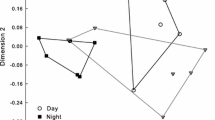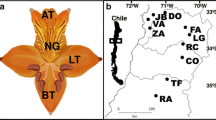Abstract
Morphological variation of flowers with different pollination modes was studied in 53 species representing five genera (Agrostemma, Dianthus, Saponaria, Silene s.l., Vaccaria) of the subfamily Caryophylloideae. All species were classified a priori as either diurnal, nocturnal, or selfing. Canonical discriminant analysis (CDA) of 13 floral characters revealed significant correlations between floral morphometry and pollination modes. A CDA of taxonomical groups represented with more than three species (Dianthus, and subgroups of Silene s.l.: Lychnis, Silene s.str., and Viscaria), revealed that the discrimination between these four taxa, based on the same floral characters, is also well supported. Main factors for the discrimination of the species with different pollination modes were characters that (a) define nectar accessibility (calyx length, calyx tooth length), (b) are related to the positioning of anthers and stigmatic areas in relation to pollinators and (c) are important for the visual attractiveness of flowers (plate width). The functional distance between the nectar source (anthophore base) and contact zone with pollinators (style tips), given as the sum of anthophore length, ovary length, and style length (hence called AOS-complex) is better correlated with the calyx length than the single characters. Further, the total AOS-complex length differs significantly between pollination modes suggesting that these characters form a functionally linked complex that is related to the pollen placement on, and stigma contact with, the pollinator's body. However, the contribution of anthophore and style length to the total AOS-complex differed significantly between Silene s.l. and other taxa indicating that the taxonomic groups follow different evolutionary ways for the construction of the functionally linked AOS-complex.
Similar content being viewed by others
References
R. Alexandersson S. D. Johnson (2001) ArticleTitlePollinator-mediated selection on flower-tube length in a hawkmoth-pollinated Gladiolus (Iridaceae) Proc. Roy. Soc. Lond. Ser. B 269 631–636
H. G. Baker (1961) ArticleTitleThe adaptation of flowering plants to nocturnal and crepuscular pollinators Quart. Rev. Biol 36 64–73
V. Bittrich (1993) Caryophyllaceae K. Kubitzki J. G. Rohwer V. Bittrich (Eds) Families and genera of flowering plants, Vol. II, Flowering plants, Dicotyledons Springer Berlin 206–236
N. B. M. Brantjes J. A. A. M. Leemans (1976) ArticleTitleSilene otites (Caryophyllaceae) pollinated by nocturnal Lepidoptera and mosquitoes Acta Bot. Neerl 25 281–295
R. W. Cruden S. Kinsman R. E. Stockjouse Y. B. Linhart (1976) ArticleTitlePollination, fecundity, and the distribution of moth-flowered plants Biotropica 8 204–210
S. L. Davis L. F. Delph (2005) ArticleTitlePrior selfing and gynomonoecy in Silene noctiflora L. (Caryophyllaceae): Opportunities for enhanced outcrossing and reproductive assurance Int. J. Plant Sci 166 475–480 Occurrence Handle10.1086/428630
C. Desfeux B. Lejeune (1996) ArticleTitleSystematics of Euromediterranean Silene (Caryophyllaceae): evidence from a phylogenetic analysis using ITS sequences C. R. Acad. Sci. Paris Sér. III 319 351–358
W. N. Ellis A. C. Ellis-Adam (1993) ArticleTitleTo make a meadow it takes a clover and a bee: the entomophilous flora of N.W. Europe and its insects Bijdragen tot de Dierkunde 63 193–220
A. Erhardt (1991) ArticleTitlePollination of Dianthus superbus L Flora 185 99–106
A. Erhardt B. Jäggi (1995) ArticleTitleFrom pollination by Lepidoptera to selfing: the case of Dianthus glacialis(Caryophyllaceae) Pl. Syst. Evol 195 67–76 Occurrence Handle10.1007/BF00982316
K. Faegri L. Pijl Particlevan der (1979) The principles of pollination ecology 3rd edn Pergamon Press Oxford
C. B. Fenster P. K. Diggle S. C. H. Barrett K. Ritland (1995) ArticleTitleThe genetics of floral development differentiating two species of Mimulus Heredity 74 258–266
C. B. Fenster W. S. Armbruster P. Wilson M. R. Dudash J. D. Thomson (2004) ArticleTitlePollination syndromes and floral specialization Annual Rev. Ecol. Evol. Syst 35 375–403
C. Friedrich (1979) Familie Caryophyllaceae G. Hegi (Eds) Illustrierte Flora von Mitteleuropa, Band III Paul Parey Berlin 763–1221
M. Fulton S. A. Hodges (1999) ArticleTitleFloral isolation between Aquilegia formosa and Aquilegia pubescens Proc. Roy. Soc. Lond. Ser. B 266 2247–2252
L. D. Gottlieb (1984) ArticleTitleElectrophoretic analysis of the phylogeny of the self-pollinating populations of Clarkia xantiana Pl. Syst. Evol 147 91–102 Occurrence Handle10.1007/BF00984582
V. Grant (1981) Plant speciation, 2nd edn Columbia University Press New York
V. Grant K. A. Grant (1965) Flower pollination in the Phlox family Columbia University Press New York
W. Greuter (1995) ArticleTitleSilene (Caryophyllaceae) in Greece: a subgeneric and sectional classification Taxon 44 543–581
R. J. Harris (1985) A primer of multivariate statistics Academic Press, Orlando Florida USA
B. P. Hermann T. K. Mal R. J. Williams N. R. Dollahon (1999) ArticleTitleQuantitative evaluation of stigma polymorphism in a tristylous weed, Lythrum salicaria (Lythraceae) Amer. J. Bot 86 1121–1129
T. P. Holtsford N. C. Ellstrand (1989) ArticleTitleVariation in outcrossing rate and population genetic structure of Clarkia tembloriensis (Onagraceae) Theor. Appl. Genet 78 480–488 Occurrence Handle10.1007/BF00290831
H. F. Howe (1984) ArticleTitleConstraints on the evolution of mutualisms Amer. Naturalist 123 764–777 Occurrence Handle10.1086/284238
S. D. Johnson K. E. Steiner (1997) ArticleTitleLong-tongued fly pollination and evolution of floral spur length in the Disa draconis complex (Orchidaceae) Evolution 51 45–53
S. D. Johnson K. E. Steiner (2000) ArticleTitleGeneralization versus specialization in plant pollination systems Trends Ecol. Evol 15 140–143 Occurrence Handle10717682
S. D. Johnson T. J. Edwards C. Carbutt C. Potgieter (2002) ArticleTitleSpecialization for hawkmoth and long-proboscis fly pollination in Zaluzianskya section Nycterinia (Scrophulariaceae) Bot. J. Linn. Soc 138 17–27 Occurrence Handle10.1046/j.1095-8339.2002.00005.x
A. Jürgens T. Witt G. Gottsberger (1996) ArticleTitleReproduction and pollination in Central European populations of Silene and Saponaria species Bot. Acta 109 316–324
Jürgens A., Witt T., Gottsberger G. (2002a) Pollen grain numbers, ovule numbers and pollen-ovule ratios in Caryophylloideae: correlation with breeding system, pollination, life form, style number, and sexual system. Sex. Pl. Repr. 14: 279–289.
Jürgens A., Witt T., Gottsberger G. (2002b) Flower scent composition in night-flowering Silene species (Caryophyllaceae). Biochem. Syst. Ecol. 30: 383–397.
A. Jürgens T. Witt G. Gottsberger (2003) ArticleTitleFlower scent composition in Dianthus and Saponaria species (Caryophyllaceae) and its relevance for pollination biology and taxonomy Biochem. Syst. Ecol 31 345–357
A. Jürgens (2004) ArticleTitleFlower scent composition in diurnal Silene species (Caryophyllaceae): phylogenetic constraints or adaptation to flower visitors? Biochem. Syst. Ecol 32 841–859
A. Kawakita T. Sota M. Ito J. S. Ascher H. Tanaka M. Kato D.W. Roubik (2004) ArticleTitlePhylogeny, historical biogeography, and character evolution in bumble bees (Bombus: Apidae) based on simultaneous analysis of three nuclear gene sequences Molec. Phylogenet. Evol 31 799–804 Occurrence Handle1:CAS:528:DC%2BD2cXivVKnurY%3D Occurrence Handle15062814
J. P. Kochmer S. N. Handel (1986) ArticleTitleConstraints and competition in the evolution of flowering phenology Ecol. Monogr 56 303–325
Kugler H. (1970) Einführung in die Blütenökologie, 2nd edn. Fischer, Stuttgart.
M. Lidén M. Popp B. Oxelman (2001) ArticleTitleA revised generic classification of the tribe Sileneae (Caryophyllaceae) Nord. J. Bot 20 513–518
V. Melzheimer (1977) ArticleTitleBiosystematische Revision einiger Silene-Arten (Caryophyllaceae) der Balkanhalbinsel (Griechenland) Bot. Jahrb. Syst 98 1–92
H. Meusel H. Mühlberg (1979) Unterfamilie Silenoideae (Lindl.) A. Br G. Hegi (Eds) Illustrierte Flora von Mitteleuropa, Band III Parey Berlin 947–1182
R. B. Miller (1981) ArticleTitleHawkmoths and the geographic patterns of floral variation in Aquilegia caerulea Evolution 35 763–774
J. Ollerton (1996) ArticleTitleReconciling ecologial processes with phylogenetic patterns – The apparent paradox of plant-pollinator systems J. Ecol 84 767–769
R. Ornduff (1969) ArticleTitleReproductive biology in relation to systematics Taxon 18 121–133
B. Oxelman M. Lidén (1995) ArticleTitleGeneric boundaries in the tribe Sileneae (Caryophyllaceae) as inferred from nuclear rDNA sequences Taxon 44 525–542
B. Oxelman M. Lidén D. Berglund (1997) ArticleTitleChloroplast rps16 intron phylogeny of the tribe Sileneae (Caryophyllaceae) Pl. Syst. Evol 206 393–410 Occurrence Handle10.1007/BF00987959
M. W. Pettersson (1991) ArticleTitlePollination by a guild of fluctuating moth populations: option for unspecialization in Silene vulgaris J. Ecol 79 591–604
M. Proctor P. Yeo A. Lack (1996) The natural history of pollination Harper Collins Publishers London
O. Rohweder (1967) ArticleTitleBlütenentwicklung und Blütenbau bei Silenoiden (Caryophyllaceae) Bot. Jahrb. Syst 86 130–185
J. Runions A. G. Geber (2000) ArticleTitleEvolution of the self-pollinating flower in Clarkia xantiana (Onagraceae). I. Size and development of floral organs Amer. J. Bot 87 1439–1451
S. Sakai M. Kato T. Inoue (1999) ArticleTitleThree pollination guilds and variation in floral characteristics of Bornean gingers (Zingiberaceae and Costaceae) Amer. J. Bot 86 646–658
D. W. Schemske H. D. Bradshaw (1999) ArticleTitlePollinator preferences and the evolution of floral traits in monkeyflowers (Mimulus) Proc. Natl. Acad. Sci. U.S.A 96 11910–11915 Occurrence Handle10.1073/pnas.96.21.11910 Occurrence Handle1:CAS:528:DyaK1MXmvVGjs70%3D Occurrence Handle10518550
D. J. Schoen (1982) ArticleTitleThe breeding system of Gilia achilleifolia: variation in floral characteristics and outcrossing rate Evolution 36 352–360
R. Scogin (1988) ArticleTitleFloral anthocyanidins of bird-visited flowers Bot. Gaz 149 437–442 Occurrence Handle10.1086/337737 Occurrence Handle1:CAS:528:DyaL1MXkslCrsLw%3D
E. Spjotvoll M. R. Stoline (1973) ArticleTitleAn extension of the T-method of multiple comparisons to include the cases with unequal sample sizes J. Amer. Stat. Assoc 68 975–978
StatSoft Inc. (1995) Statistica for Windows. Stat-Soft. Inc., Tulsa, Oklahoma.
G. L. Stebbins (1970) ArticleTitleAdaptive radiation of reproductive characteristics in angiosperms, I: Pollination mechanisms Annual Rev. Ecol. Syst 1 307–326 Occurrence Handle10.1146/annurev.es.01.110170.001515
G. L. Stebbins (1974) Flowering plants: evolution above the species level Harvard University Press Belknap
Vogel S. (1954) Blütenbiologische Typen als Elemente der Sippengliederung dargestellt anhand der Flora Südafrikas. Botanische Studien Heft 1. Fischer, Jena.
S. Vogel (1998) ArticleTitleRemarkable nectaries: structure, ecology, organophyletic perspectives III Nectar ducts. Flora 193 113–131
N. M. Waser L. Chittka M. V. Price N. M. Williams J. Ollerton (1996) ArticleTitleGeneralization in pollination systems, and why it matters Ecology 77 1043–1060
P. Wilson M. C. Castellanos J. N. Hogue J. D. Thomson W. S. Armbruster (2004) ArticleTitleA multivariate search for pollination syndromes among penstemons Oikos 104 345–361 Occurrence Handle10.1111/j.0030-1299.2004.12819.x
T. Witt A. Jürgens R. Geyer G. Gottsberger (1999) ArticleTitleNectar dynamics and sugar composition in flowers of Silene and Saponaria species (Caryophyllaceae) Plant Biol 3 334–345
T. Witt (2003) Reproduktionsbiologie von Caryophyllaceen (Unterfamilie Caryophylloideae) unter besonderer Berücksichtigung der Nektarproduk- tion. Ph.D Thesis University of Ulm Germany
Wolff D., Witt T., Jürgens A., Gottsberger G. (2005) Nectar dynamics and reproductive success in Saponaria officinalis (Caryophyllaceae) in southern Germany. Flora (accepted).
R. Wyatt (1983) Pollinator-plant interactions and the evolution of breeding systems L. Real (Eds) Pollination biology Academic Press, Orlando, Florida USA 51–95
R. Wyatt (1988) ArticleTitlePhylogenetic aspects of the evolution of self-pollination in Arenaria uniflora (Caryophyllaceae) J. Ecol 74 403–418
Author information
Authors and Affiliations
Corresponding author
Rights and permissions
About this article
Cite this article
Jürgens, A. Comparative floral morphometrics in day-flowering, night-flowering and self-pollinated Caryophylloideae (Agrostemma, Dianthus, Saponaria, Silene, and Vaccaria). Plant Syst. Evol. 257, 233–250 (2006). https://doi.org/10.1007/s00606-005-0379-4
Received:
Accepted:
Published:
Issue Date:
DOI: https://doi.org/10.1007/s00606-005-0379-4




